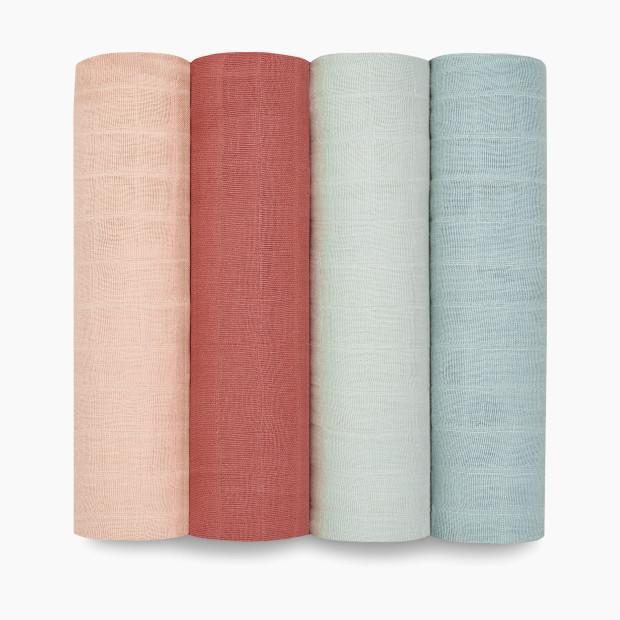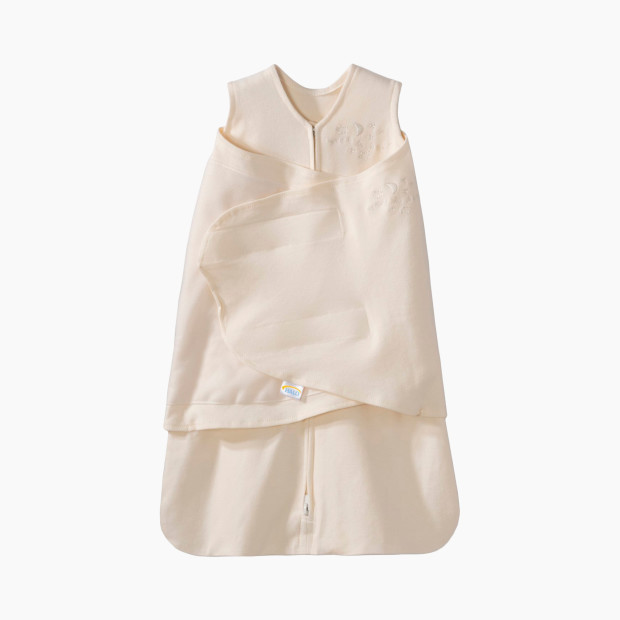
What's the Difference Between a Swaddle and a Sleep Sack?
How to create a safe (and comfortable) sleep solution for your baby—and our favorite product picks.

In This Article
What diaper bag will hold the most stuff, how many bibs to register for, which stroller will be your go-to...we know there’s a lot to remember as a parent-to-be, whether you’re just beginning to think about creating your registry or you’ve been at your new parent gig for a few weeks already.
Safe sleep guidelines are a biggie. Knowing what’s safe and what’s not when it comes to baby sleep is pretty important, and since you’ve got a lot of nap times and bedtimes ahead of you, you’ll need to know what’s what when it comes to babies + blankets, swaddles and sleep sacks.
We’re making all your baby burrito dreams come true and sharing the need-to-knows around safe baby sleep solutions, from figuring out the differences between swaddles and sleep sacks to learning what’s safe to use and when.
Safe Sleep 101
The American Academy of Pediatrics has many resources on safe sleep that are helpful to familiarize yourself with before your little one arrives. In the meantime, here’s a basic breakdown of what they recommend:
Use a firm, flat sleep surface.
Until their first birthday, always place your baby on their back for all sleep, including naps and at night.
Room share for the first six months.
Never bring your baby into bed with you for sleep, and never let your little one sleep on a couch or armchair.
It’s okay to swaddle your baby—but make sure the swaddle isn’t too tight (or too loose), make sure baby is always on their back when swaddled and stop as soon as your little one starts trying to roll over. And do not use weighted swaddles.
Keep objects (toys, stuffed animals, etc.) and loose bedding like pillows, quilts, blankets, etc. out of baby’s sleep space.
Don't let your baby get overheated.
That last point—no blankets or other loose bedding in baby’s sleep space—is where things can get a bit confusing. If you’re having a baby during the cooler months, or your little one is sleeping in a cold room, you’ll want something to keep them warm. And that’s where swaddle blankets and sleep sacks come in.
Difference Between a Swaddle Blanket and a Sleep Sack
It’s important to know the difference between a swaddle blanket and a sleep sack, also called a sleep bag, as well as how and when to use each, as you figure out what to add to your baby registry or purchase yourself during those early newborn days.
A swaddle blanket is a blanket that’s designed for swaddling your newborn. Swaddling is a way of wrapping a blanket securely around your baby so they can’t wriggle out. (Cue all the adorable baby burrito photos.) Swaddling is great for a few reasons:
It keeps your baby feeling safe and secure, mimicking the tight feeling they experienced in the womb.
It prevents the newborn startle reflex from waking them up. (That’s what’s happening when you see your little one’s arms or legs jerk suddenly in their sleep.)
It keeps your little one warm without loose blankets.
There are two basic types of swaddles, traditional and two-in-ones. A traditional swaddle blanket is a large, thin blanket, usually made of a soft, stretchy fabric like muslin, cotton or bamboo. Two-in-one swaddles let you wrap your little one snugly or leave their arms out. They often come with features like snaps, zippers or Velcro that help make swaddling easier and ensure the swaddle stays secure.
A sleep sack is like a mini sleeping bag for your baby and toddler. Sometimes also called a wearable blanket, a sleep sack is another alternative for keeping your little one warm without using loose blankets in the crib. Sleep sacks are usually made of cotton, fleece or wool and feature zippers and snaps for easy on and off.
Can You Swaddle and Use a Sleeping Bag?
There are many sleeping bags that have swaddles built right in. Often called two-in-one swaddles, they feature a roomy sleep sack-style design on the bottom and a swaddle feature on top. (Think wings that wrap around your baby’s arms to keep them immobilized.) Some of these swaddles transition to let your baby sleep with their arms out once they’re ready.
When to Transition from a Swaddle to a Sleep Sack
According to the AAP, when done correctly, swaddling is safe and can be an effective tool for helping calm your little one and promote longer stretches of sleep. But it’s important to know when to stop swaddling and transition to a sleep sack instead.
You should stop swaddling your baby when they begin trying to roll over. Timing will vary for every baby, but this milestone usually happens around four months old. Swaddling can be dangerous for rolling babies—they won’t have their arms free, so if they roll over while swaddled it can place them in an unsafe sleep situation.
Babylist Picks for the Best Swaddle Blankets and Sleep Sacks
If you’re thinking of adding swaddles and sleep sacks to your baby registry, we recommend starting small. Pick one traditional-style swaddle and one or two two-in-one styles, then wait until your little one arrives to figure out which swaddle you (and your baby!) like the best. Same goes for when it’s time to transition to a sleep sack; try one or two first, then build from there.
Here are our top picks for safe sleep solutions in every category.
Best Swaddle Box
Confused about which swaddle to buy? Worry your baby (or you) won’t like your pick? Start with the Swaddle Box. This thoughtful bundle includes four popular swaddles, each in a different style and from a different brand, so you can try before you stock up. Evertyhing is included in a beautiful box, making this collection a great gift either for someone else or for yourself.
Best Muslin Swaddles
There’s a reason these muslin swaddles have remained a registry staple for years. They’re light, breathable, come in a huge assortment of great prints and are versatile enough to use beyond just swaddling.
Softest Swaddle Blanket
For a alternative to muslin, Copper Pearl’s soft, stretchy rayon blend swaddle blanket gets our vote. We love the extra-large size and signature patterns.
Best Arms-Up Swaddle
This simple, creative swaddle sack solves for the fact that babies’ natural sleep position is often with their arms up. It gives them access to their hands for self soothing but simultaneously helps to manage the startle reflex.
Easiest Swaddle
We love the unique and foolproof design of this quick and easy swaddle sack. There’s an inner band that keeps baby’s arms snug and secure paired with a zip-up, hip-safe outer sack for warmth and comfort. And the Velcro is extra quiet, too.
Best Transitional Swaddle
When your little one is ready to transition from a swaddle blanket to a sleep sack, simply stop using the Velcro wings of this popular swaddle to let their arms out. We also like the mid-weight cotton material here that works for a variety of sleep environments.
Best Sleep Sack
This is the wearable blanket of choice once it’s time for your baby to make the transition from swaddle to sleep sack. The simple design, bottom-up zipper (great for nighttime diaper changes) and affordable price point make the Halo a parent favorite.
Softest Sleep Sack
For an incredibly soft sleep sack option that’s also eco-friendly, the Kyte Baby sleep bag is the way to go. It’s made from breathable, ethically sourced bamboo and works in sleep spaces with an ambient temperature between 69 and 73 degrees Fahrenheit.
Best Wool Sleep Sack
Merino wool keeps baby at just the right temperature no matter the season. This year-round sleep sack works for temps as low as 63 degrees Fahrenheit up to 77. It’s also universally sized for babies and toddlers ages two months to two years.
For a full selection of our favorite swaddles blankets and sleep sacks, check out our Best Swaddles and Best Sleep Sacks guides.









